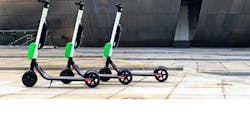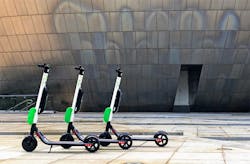Transportation is constantly changing. First it was the self-balancing Segways that took advantage of new batteries, motors, and DSPs that could keep the two-wheeler upright. Hoverboards actually turned out to be less expensive and more popular, even when a few turned out to be better fire starters than transportation vehicles. Then it was the likes of Uber and Lyft that turned the GPS-equipped smartphone into a ride-hailing tool. Each took new technology and turned the transportation industry on its ear.
What’s next? Self-driving cars?
The latest scourge or salvation, depending on your point of view, are dockless bikes and scooters from the likes of Bird, LimeBike (Fig. 1), and Spin (Fig. 2). The bicycles are typical fare with added integral locks, cellular communication, and GPS. The scooters are self-propelled with electric motors and batteries. They also have integral locks, cellular communication, and GPS. Bikes will run as long as they’re pedaled, while the scooters have a runtime measured in hours, so most will run all day providing short hops. Other alternatives work better if the distance is large.
1. LimeBike offers dockless scooters in addition to bikes.
The bikes and scooters perform similarly to how self-driving cars will supposedly operate, although a self-driving car will come to you. For the bikes and scooters, you need to find one nearby—that’s why the dockless solutions are more popular than their docked counterparts. The latter requires a ride to start and end at a dock, where the units are usually locked in place. That works if the docks are located near your transportation needs. Unfortunately, adding or removing docks is a very expensive proposition.
Dockless solutions overcome this hurdle. The smartphone app associated with these dockless marvels use GPS to locate the user and the nearest ride. The smartphone’s camera is used to scan the QR or OCR code on the ride to identify, as there may be multiple rides to select from. After unlocking the ride via cellular network and cloud, it can subsequently be as needed and parked at the destination. A typical ride is only a few dollars compared to significantly more for alternatives (other than walking). The ride is left at the destination, where it’s locked and made available for the next rider.
Rides can be picked up as needed to recharge, in the case of electric scooters, to relocating rides where they’re needed. One might expect bidirectional travel, but that’s not always the case. A ride sitting in the middle of nowhere doesn’t make money.
2. Spin also supports dockless bikes as well as scooters.
The vehicles are tracked via GPS, which limits stolen vehicles, although vandalism can be a problem. Unfortunately, many other problems arise from rides parked in unwanted areas where they may block pedestrians or other vehicles. Poor driving habits and lack of helmets are also common complaints. Companies and cities are working to address these issues.
Of course, similar complaints are made about cars that double park or park in restricted areas. These often result in fines, something that’s also occurring with these dockless solutions.
One technique being applied to address some of these issues is called “geofencing.” This uses GPS and maps to locate areas where a ride is allowed to be parked. Actually, these systems normally use designated areas where something should not be parked. Ways to encourage proper use and discourage bad habits is still an open question, but one that companies and cities often cooperate on.
Bike-friendly communities often fare better with dockless solutions, since they tend to separate pedestrians, bikes and scooters, and cars. A mix results in a more efficient and ecofriendly environment.
This will not be the end to innovations. Just wait until these vehicles are equipped with cameras to identify riders and track traffic. It will be possible to use a ride without needing a smartphone, although they do provide useful feedback, such as the cost of a ride.



